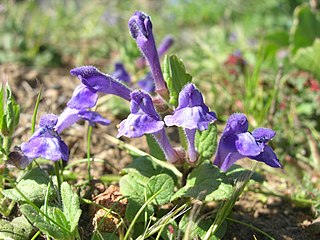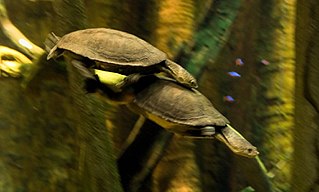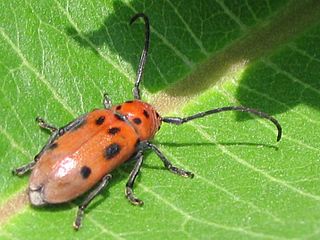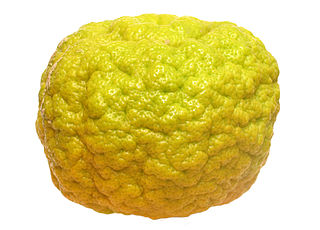
Asclepias tuberosa, commonly known as butterfly weed, is a species of milkweed native to eastern and southwestern North America. It is commonly known as butterfly weed because of the butterflies that are attracted to the plant by its color and its copious production of nectar.

Oxalis tuberosa is a perennial herbaceous plant that overwinters as underground stem tubers. These tubers are known as uqa in Quechua, oca in Spanish, yams in New Zealand and several other alternative names. The plant was brought into cultivation in the central and southern Andes for its tubers, which are used as a root vegetable. The plant is not known in the wild, but populations of wild Oxalis species that bear smaller tubers are known from four areas of the central Andean region. Oca was introduced to Europe in 1830 as a competitor to the potato, and to New Zealand as early as 1860.

Agave amica, formerly Polianthes tuberosa, the tuberose, is a perennial plant in the family Asparagaceae, subfamily Agavoideae, extracts of which are used as a note in perfumery. Now widely grown as an ornamental plant, the species is native to Mexico.

Sometimes called the bearded toadheads but better known by their scientific name of Phrynops this genus of turtles has often been a bit of a dumping ground for the short-necked South American turtles of the family Chelidae.

Stemona tuberosa is a species of flowering plant in the family Stemonaceae. It is native to China, India, southeast Asia, and New Guinea. Hornets play an important role in seed dispersal by biting off the seed with its elaiosome and then carrying the seed away for about 100 m. There they chew off the elaiosome and abandon the seed which is likely to be taken by ants into their nest.

Cassis tuberosa, the king helmet, is a species of very large sea snail with a solid, heavy shell, a marine gastropod mollusc in the family Cassidae, the helmet shells and their allies.

Scutellaria tuberosa is a species of flowering plant in the mint family known by the common name Danny's skullcap. It is native to western North America from Oregon through California to Baja California, where it is widespread throughout the mountain and coastal regions; it is absent from the deserts and the Central Valley of California. It can be found in forest and woodland habitat, and a variety of open habitat types, often appearing in areas recently cleared by wildfire. It is a perennial herb producing an erect stem or cluster of stems up to about 25 centimeters tall from a root system with tubers. The stems are coated in short, spreading hairs. The oval leaves are oppositely arranged. The lowest leaves are borne on short petioles. Flowers emerge from the leaf axils. Each flower is held in a calyx of sepals with a large ridge or dome-shaped appendage on the upper part. The tubular corolla is one to two centimeters long and has a large upper and lower lip. The upper lip is folded into a beaklike protrusion and the lower has three wide lobes. The corolla is deep purple-blue, usually with a white patch or mottling on the lower lip.

Collybia tuberosa, commonly known as the lentil shanklet or the appleseed coincap, is an inedible species of fungus in the family Tricholomataceae, and the type species of the genus Collybia. Like the two other members of its genus, it lives on the decomposing remains of other fleshy mushrooms. The fungus produces small whitish fruit bodies with caps up to 1 cm (0.4 in) wide held by thin stems up to 5 cm (2.0 in) long. On the underside of the cap are closely spaced white gills that are broadly attached to the stem. At the base of the stem, embedded in the substrate is a small reddish-brown sclerotium that somewhat resembles an apple seed. The appearance of the sclerotium distinguishes it from the other two species of Collybia, which are otherwise very similar in overall appearance. C. tuberosa is found in Europe, North America, and Japan, growing in dense clusters on species of Lactarius and Russula, boletes, hydnums, and polypores.

Pueraria tuberosa, commonly known as kudzu, Indian kudzu, or Nepalese kudzu, Vidarikand, Sanskrit: Bhukushmandi (भूकुशमंडी) is a climber with woody tuberculated stem. It is a climbing, coiling and trailing vine with large tuberous roots. The tubers are globose or pot-like, about 25 centimetres (9.8 in) across and the insides are white, starchy and mildly sweet. Leaves are trifoliate and alternate, while the leaflets are egg-shaped, with round base and unequal sides. They are 18 cm (7.1 in) long and 16 cm (6.3 in) wide and are hairless above. Flowers are bisexual, around 1.5 cm (0.59 in) across and blue or purplish-blue in color. The fruit pods are linear, about 2–5 cm (0.79–1.97 in) long and constricted densely between the seeds. They have silky, bristly reddish-brown hair. Seeds vary from 3 to 6 in number.

Phrynops tuberosus, commonly known as the Cotinga River toadhead turtle, is a large species of side-necked turtle in the family Chelidae. The species is endemic to South America.

Iris tuberosa is a species of tuberous flowering plant of the genus Iris, with the common names snake's-head, snake's-head iris, widow iris, black iris, or velvet flower-de-luce.

Ruellia tuberosa, also known as minnieroot, fever root, snapdragon root and sheep potato, is a species of flowering plant in the family Acanthaceae. Its native range is in Central America but it has become naturalized in Africa, South and Southeast Asia.

Onciderini is a tribe of longhorn beetles of the subfamily Lamiinae, they are prevalent across Europe in nations such as Turkey, and Finland.

Rhobs al-Arsa is a very popular citrus fruit in Morocco.

Oncideres is a genus of longhorn beetles of the subfamily Lamiinae, containing more than 120 species in the nearctic and neotropics.

Tetraopes is a genus of longhorn beetles of the subfamily Lamiinae, tribe Tetraopini, containing the following species:

Phlomoides tuberosa, the sage-leaf mullein, is a perennial herbaceous flowering plant in the family Lamiaceae, native to China, Kazakhstan, Kyrgyzstan, Mongolia, Russia; SW Asia and Europe. Enlarged, tuberous roots give rise to erect stems to 150 cm bearing purple-red flowers.

Oncideres albomarginata is a species of beetle in the family Cerambycidae. It was described by James Thomson in 1868. It is known from Costa Rica, Ecuador, Colombia, Guatemala, Panama, Guyana, Mexico, Nicaragua, Venezuela, and Trinidad and Tobago.
Oncideres chevrolatii is a species of beetle in the family Cerambycidae. It was described by James Thomson in 1868. It is known from Brazil.

Pompia, also called pumpia, sa pompia, spompia, and China citron, is a Citrus hybrid cultivated for its edible fruit. It is a taxonomical synonym of Citrus medica.

















